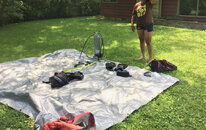What is the most effective way to rinse off your reg after a salt water dive? I like to dip them in VERY warm water to get rid of the salt, but is it good for the material that is inside of the second stage? (Mine is a SP A700). Just want to confirm! Thanks
My just-certified college student returned last week from Roatan. She took my old (1994) Scubapro Stab Jacket + AIR 2 + Wenoka Dive Knife and Scubapro Mk 10 + Balanced Adjustable. and Riffe snorkel. Of course she rinsed everything there in a fresh (?) water rinse tank before heading home.
However, once home, we cleaned gear the way I "always" have (when the weather is nice enough, that is)--namely, on a tarp, on the lawn, with the reg (and AIR 2) attached to a cylinder and pressurized, and a lot of high-flow water from the garden hose, being careful to "work" all swivels and connections and buttons, and open all pockets and zippers and velcro, etc. (Don't forget the ambient pressure chamber on the Mk 10!) BC is washed (rinsed) inside and out, and drained through the OPR valves and the AIR 2, a couple of times. And hands are used to "wash" the outside of the BC, front and back, and the hoses, a couple of times.
Afterward, wetsuit, hood, gloves, and booties are cleaned in the bathtub with wetsuit shampoo, rinsed, soaked in Sink-the-Stink, and then hung up to dry.
Ever since I started buying gear in 1987. Works every time.
rx7diver




